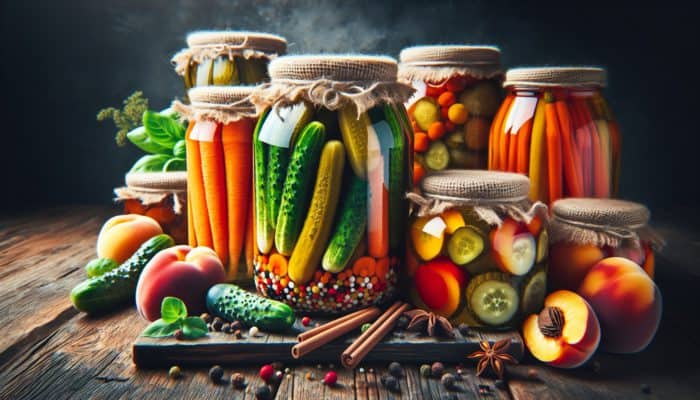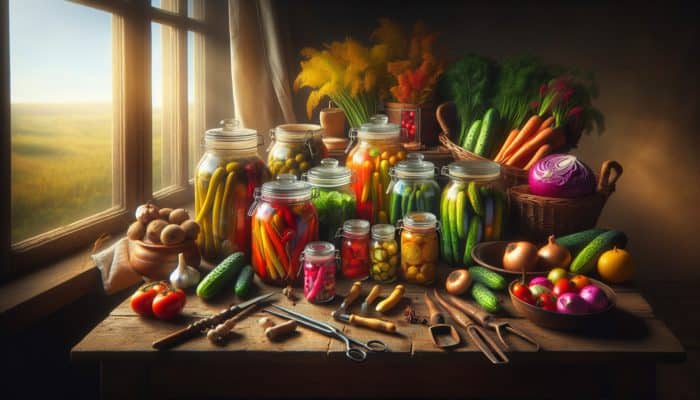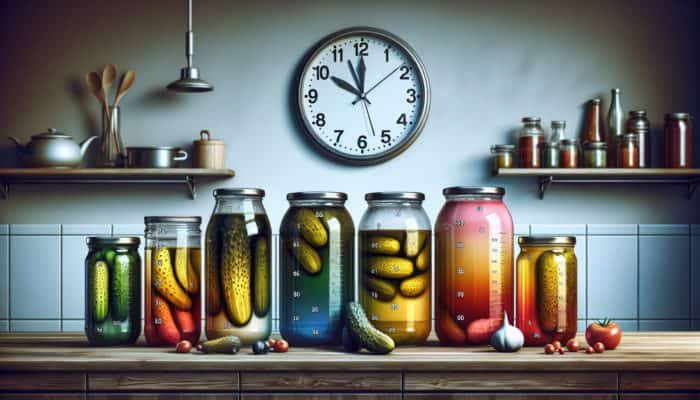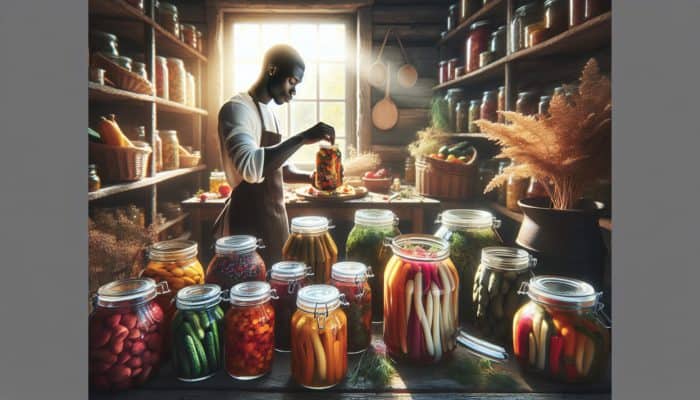Discovering The Art Of Pickling For Food Preservation
What Exactly Is Pickling?

Best Methods for Pickling at Home: Pickling is a vital technique for food preservation, utilising an acidic solution, often vinegar or brine, to prolong the shelf life of various food items. The pickling process not only intensifies the flavour but also produces a distinctive texture that many culinary enthusiasts admire. A variety of fruits and vegetables, including cucumbers, carrots, and even fruits like peaches, can be transformed into mouth-watering pickled delicacies. The heart of pickling lies in achieving the right balance of acidity, sugar, and spices, which together create a rich flavour profile that excites the palate.
- Cucumbers
- Carrots
- Beets
- Green beans
- Cauliflower
- Onions
- Garlic
- Fruits (like peaches and watermelon)
Across the globe, diverse cultures have embraced the art of pickling, establishing it as a universal method for preserving food. Whether savouring pickled kimchi in Asia or enjoying tangy sour gherkins in Europe, the tradition of pickling has been handed down through generations, demonstrating its significance in enhancing flavour and ensuring food safety.
What Equipment Is Essential For Successful Pickling?
Before embarking on your pickling journey, it is essential to gather the necessary equipment that will support your home pickling adventure. Having the right tools not only streamlines the process but also ensures safety during the pickling process. Here’s a comprehensive list of essential equipment:
- Glass jars with secure lids
- Large pot for sterilisation
- Tongs
- Funnel
- Measuring cups and spoons
- Thermometer (for checking brine temperature)
- Cutting board and knife
- Labels for storage
Glass jars are preferred as they do not react with acidic solutions and allow you to monitor the contents visually. Sterilising jars is vital to prevent contamination and spoilage; therefore, it is recommended to sterilise your jars in boiling water before use. The funnel will facilitate pouring the brine without spills, ensuring a neat and efficient process. As you prepare your pickling station, keeping these tools organised will enhance your experience, allowing you to concentrate on crafting delicious pickles.
What Safety Measures Should Be Taken When Pickling At Home?
Ensuring safety in the pickling process is paramount, as improper techniques can lead to spoilage and potential foodborne illnesses. Adhering to hygiene practices and understanding the need for sterilisation is essential for safe pickling. Always start with fresh, high-quality ingredients to ensure the best results. Here are some safety measures to consider:
- Thoroughly wash your hands and all equipment.
- Utilise only fresh, unblemished produce.
- Follow established recipes for accurate vinegar concentrations.
- Store pickles in the refrigerator if they are not processed.
- Watch for signs of spoilage, such as unusual smells or mould.
- Employ suitable sealing methods for jars to prevent contamination.
- Label jars with dates and contents for easy tracking.
- Educate yourself on safe canning practices if you’re new to pickling.
Implementing these precautions will not only extend the shelf life of your pickled products but also ensure their safety for consumption. Remember, a knowledgeable pickler is a successful pickler, so dedicate time to learning about food safety for an enjoyable and worry-free pickling experience.
Expert Recommendations For Successful Home Pickling Techniques

What Methods Do Experienced Picklers Suggest?
When it comes to home pickling, seasoned experts generally advocate for two primary techniques: the water bath canning method and the fermentation method. Each method possesses unique benefits, catering to different flavours and preservation preferences. The water bath canning method is particularly recommended for high-acid foods, such as cucumbers, as it ensures safety by effectively eliminating harmful bacteria through boiling.
In contrast, the fermentation method capitalises on the natural bacteria found on vegetables, resulting in a tangy and probiotic-rich pickle that can significantly benefit gut health. For example, traditional Korean kimchi is a fermented dish that exemplifies the rich flavours achievable through this technique. Real-world applications of these methods illustrate the vast diversity of pickling—from the crisp, tangy dill pickles of North America to the spiced, fermented vegetables prevalent in Asian cuisines, the opportunities are boundless. Choose a method based on your desired outcome—whether it be a quick, safe preserve or a complex, flavourful ferment.
How Do You Select The Best Ingredients For Pickling?
The success of your pickling venture largely depends on the quality of the ingredients you use. Selecting fresh, high-quality produce is a non-negotiable requirement. Opt for seasonal ingredients to ensure peak flavour and optimal texture. When choosing vinegar or brine, consider that different types can drastically affect the taste of your pickles. Here’s how to select the finest ingredients:
- Inspect produce for firmness and freshness.
- Choose organic options where feasible to avoid pesticides.
- Experiment with various vinegars (white, apple cider, rice vinegar).
- Consider using sea salt instead of table salt for enhanced flavour.
- Add spices that harmonise with your main ingredient (e.g., dill with cucumbers).
- Seasonal ingredients often yield the most vibrant flavours.
- Research local varieties for unique flavours.
- Trust your palate—choose what tastes best to you.
By meticulously selecting your ingredients, you not only amplify the flavour of your pickles but also engage in a sustainable practice by supporting local markets and consuming seasonal produce. This thoughtful approach to ingredient selection elevates your pickling to a new level of culinary creativity.
What Common Mistakes Should You Avoid When Pickling?

When embarking on your pickling adventure, several common mistakes can impede your results. Being aware of these common pitfalls is vital for achieving the best possible pickles. Overfilling jars is a frequent error; it restricts the brine’s ability to circulate and fully flavour the ingredients. Additionally, overlooking proper sterilisation can jeopardise safety and freshness.
Another common mistake involves using vinegar with inadequate acidity levels, which fails to preserve the food effectively. The appropriate vinegar concentration is critical; typically, a 5% acidity level is deemed safe for pickling. Moreover, failing to allow sufficient time for flavours to meld can result in bland pickles. Understanding these pitfalls empowers you to refine your technique and produce pickles that not only taste fantastic but are also safe for consumption. Adjust your methods, keep experimenting, and you’ll discover your path to pickling perfection.
How Can You Amplify The Flavour Of Pickled Foods?
What Spices And Herbs Are Ideal For Pickling?
Spices and herbs serve as the backbone of flavour in pickling, enabling you to create a depth of taste that elevates your pickled products. Popular choices include dill, mustard seeds, garlic, and peppercorns. Each of these ingredients contributes its distinct flair and can be combined in various ways to craft unique flavour profiles.
Dill is a classic option for cucumber pickles, imparting a fresh, herbaceous note that complements the natural sweetness of the cucumbers. Mustard seeds add a mild heat and crunch, making them an excellent enhancement for a variety of pickles. Garlic introduces a robust flavour, while peppercorns provide a slight bite that enriches the overall complexity. When experimenting with spices, consider these tips:
- Begin with small quantities and adjust to taste.
- Combine spices for a distinctive blend (e.g., dill, garlic, and coriander).
- Infuse the brine with spices for an aromatic experience.
- Keep records of combinations that work well together.
Experimentation is essential for discovering your favourite flavour profiles. Don’t hesitate to try unconventional herbs or spices, as the realm of pickling is ripe for innovation. By exploring different combinations, you can create pickles that are uniquely yours.
Can Sweetness Be Added To Pickles?
Indeed, adding sweetness to pickles is not only feasible but can also elevate the overall flavour profile by creating a delightful balance between sweet and tangy. Ingredients like sugar or honey can complement the acidity of vinegar, adding depth to the taste. This balance is particularly enjoyable in recipes like bread and butter pickles, where sweetness is a defining characteristic.
When incorporating sweetness, it’s vital to determine the appropriate amount. Excess sweetness can overwhelm the pickles, while too little might leave them lacking. Begin with small quantities and adjust according to your taste. Consider using different types of sweeteners for varied effects; for instance, honey imparts a floral note, while brown sugar adds depth and a hint of caramelisation. Here are some suggestions for achieving the right balance of sweetness:
- Pair sweetness with spices for added complexity (e.g., cinnamon or cloves).
- Utilise natural sweeteners to maintain a healthier profile.
- Test and adjust during the pickling process.
- Take into account the main ingredient's flavour when introducing sweetness.
By thoughtfully incorporating sweet elements, you can create a harmonious taste that appeals to a diverse range of palates, thereby enhancing the enjoyment of your pickled creations.
How Long Should You Allow Pickles To Ferment?
The fermentation duration for pickles can vary significantly depending on the recipe and your desired flavour profile. Typically, the timeframe can range from a few days to several weeks. Longer fermentation allows for deeper flavour development and complexity, making it a vital factor in achieving the ideal pickle. For instance, traditional dill pickles usually require a minimum of a week, while lacto-fermented varieties might need a more extended period to cultivate beneficial bacteria.
During the fermentation phase, it is essential to periodically taste your pickles. This practice will help you monitor flavour development and determine when they reach your preferred level of tanginess. Keep in mind that warmer conditions can accelerate fermentation, while cooler environments will decelerate it. Here are some guidelines for successful fermentation:
- Look for bubbles—this indicates active fermentation is occurring.
- Utilise a weight or lid to keep vegetables submerged in brine.
- Store in a cool, dark location away from direct sunlight.
- Taste regularly to track flavour changes.
Patience is crucial in this process; waiting for the right moment can lead to a rewarding explosion of flavour in your pickles. The beauty of fermentation lies in its unpredictability and the artisanal touch it adds to your pickles.
How Does The Choice Of Vinegar Influence Pickle Flavour?
The type of vinegar you select plays a significant role in shaping the overall flavour of your pickles. Various vinegars, such as white vinegar, apple cider vinegar, and rice vinegar, each impart distinct characteristics and flavour nuances. For example, white vinegar is sharp and clean, making it an ideal choice for traditional pickles. In contrast, apple cider vinegar offers a fruity undertone that enhances the natural flavours of the produce.
Rice vinegar, however, is milder and slightly sweet, rendering it perfect for pickling Asian-inspired vegetables. Each type of vinegar can transform your pickling experience, making it worthwhile to experiment with different options. Here are some factors to consider when selecting vinegar:
- Match the vinegar flavour with the main ingredient (e.g., apple cider with apples).
- Consider acidity levels—aim for at least 5% acidity.
- Opt for organic vinegars for a more robust flavour.
- Experiment by blending different vinegars for a unique taste.
By understanding how vinegar affects flavour, you can tailor your pickling recipes to create delightful and complex profiles that make your pickles stand out. Whether you prefer a sharp crunch or a sweet tang, the right vinegar can be transformative in your pickling journey.
Can The Strength Of The Brine Impact The Taste Of Pickles?
Absolutely, the strength of your brine—specifically the salt concentration—has a significant impact on the final flavour and preservation of your pickles. A higher salt concentration can enhance the flavour and texture of the pickles, providing a satisfying crunch while effectively preventing spoilage due to its preservative qualities. Achieving the right balance of salt is crucial; too little can result in bland pickles, while too much can render them inedible.
Typically, a brine solution consists of a ratio of water to vinegar and salt, and finding that optimal balance is essential. Many recipes suggest a brine strength of 2-3 tablespoons of salt per quart of liquid. However, preferences can vary based on regional tastes; for instance, a southern-style pickle might favour a sweeter, less salty brine. Here’s how to effectively manage brine strength:
- Start with standard recipes for guidance and adjust as needed.
- Experiment with different types of salts, such as kosher, sea, or pickling salt.
- Consider the overall flavour balance in your final product.
- Monitor brine concentration throughout the pickling process.
Understanding brine strength not only improves the preservation of your pickles but also contributes to the overall sensory experience of your pickled foods. Mastering this aspect will enable you to create pickles that are bursting with flavour and perfectly preserved.
What Advantages Does Home Pickling Offer?
Does Pickling Help Preserve Nutrients?
Yes, pickling can effectively retain nutrients, particularly when vinegar is utilised. Many of the vitamins and minerals present in fruits and vegetables, such as vitamin C and antioxidants, are preserved during the pickling process. This characteristic makes pickled foods not only a delightful addition to meals but also a nutritious one. For instance, pickled cucumbers can retain their vitamin content while providing beneficial probiotics in fermented varieties.
Moreover, the preservation method allows you to enjoy seasonal produce throughout the year. By pickling your summer harvest, you can savour the flavours of fresh vegetables even during the coldest months. This aspect of pickling offers a sustainable approach to maintaining a healthy diet while reducing food waste. Here’s why preserving nutrients through pickling is advantageous:
- Retains vitamins and minerals compared to other preservation methods.
- Provides a source of probiotics in fermented varieties.
- Allows enjoyment of seasonal produce out of season.
- Can enhance overall diet quality with healthy additions.
By incorporating pickled foods into your meals, you not only enhance flavour but also contribute to a balanced, nutrient-rich diet. This makes pickling an appealing option for health-conscious individuals eager to explore new culinary techniques.
Can Pickling Be A Cost-Effective Method?
Absolutely, pickling can be an exceedingly economical way to preserve food. By taking advantage of seasonal produce, you can enjoy lower prices and access to an abundance of supplies. Making large batches of pmaximises your investment, allowing you to buy in bulk during peak seasons and create delicious preserves that can be enjoyed throughout the year.
Furthermore, pickling helps prevent food waste by enabling the utilisation of surplus vegetables from your garden or local markets. This practice not only saves money but also encourages resourcefulness in the kitchen. Here are a few ways pickling can lead to significant savings:
- Utilise leftover vegetables that might otherwise spoil.
- Purchase seasonal produce at lower prices.
- Create large batches for long-term storage.
- Reduce grocery bills by making your own condiments.
The financial benefits of pickling extend beyond immediate savings; it’s a sustainable practice that fosters a deeper appreciation for food and encourages mindful consumption. Engaging in this rewarding activity can lead to tangible savings on your grocery bills while simultaneously enhancing your culinary skills.
Is Pickling An Environmentally Conscious Practice?
Yes, pickling aligns seamlessly with environmentally friendly practices. It diminishes food waste by preserving excess produce that might otherwise be discarded. Additionally, by making your own pickles, you eliminate the need for commercial packaging, which often involves plastic and contributes to environmental pollution.
Home pickling is a sustainable method of food preservation that supports local farmers and markets by promoting the consumption of seasonal produce. By purchasing fresh, local produce for your pickling endeavours, you contribute to a more sustainable food system. Here’s how pickling can promote environmental responsibility:
- Minimises food waste by preserving surplus produce.
- Reduces reliance on single-use plastic packaging.
- Encourages the use of seasonal and local ingredients.
- Supports a circular economy through food preservation.
Engaging in pickling not only benefits your palate but also your planet. By choosing to pickle at home, you actively participate in a movement towards sustainability, making a positive impact on your environment.
Can Pickling Enhance the Flavour of Foods?
Yes, pickling can significantly enhance the flavour of food, transforming ordinary ingredients into extraordinary culinary delights. By incorporating elements such as vinegar, salt, and various spices, pickling creates complex flavour profiles that enhance the taste of dishes. A well-crafted pickle can elevate anything from sandwiches to salads, providing a zesty contrast that excites the palate.
The art of pickling allows for creativity and experimentation, enabling you to customise flavours to suit your preferences. Whether you're seeking something tangy, sweet, or spicy, pickling offers a versatile method to enhance your meals. Here are some ways pickling enhances food flavour:
- Brings out the natural sweetness in vegetables.
- Provides a tangy contrast to rice dishes.
- It can be paired with meats and cheeses for a balanced flavour.
- Offers a unique twist to classic recipes.
By embracing the flavours of pickling, you can transform humble ingredients into flavourful companions that enrich your culinary repertoire. This versatility makes pickled foods a valuable addition to any kitchen.
Is Pickling An Accessible Home Activity?
Indeed, pickling is a straightforward and enjoyable activity that anyone can undertake at home with minimal equipment. The process is accessible, allowing individuals to explore their culinary creativity without requiring extensive training or complex machinery. With just a few jars, some fresh produce, and a basic brine recipe, you can start making delicious pickles in no time.
Furthermore, pickling is a fun way to engage with family and friends, fostering creativity and culinary exploration. It encourages experimentation with flavours and ingredients, making it a fulfilling hobby for anyone interested in cooking. Here are some aspects that highlight the simplicity of pickling:
- Minimal equipment is required for successful pickling.
- Easy-to-follow recipes available for beginners.
- Quick process with rewarding results.
- Accessible to anyone, regardless of cooking skill level.
With its approachable nature and engaging process, pickling can become a beloved ritual in your home. It invites you to explore diverse flavours while preserving the best of seasonal produce, making it a delightful and rewarding activity.
Proven Strategies For Mastering Home Pickling Techniques
How Can You Achieve Consistent Results In Pickling?
To attain consistent results in pickling, precision is paramount. Adhering strictly to recipes and maintaining consistent temperatures throughout the process ensures that your pickles turn out perfectly every time. This meticulous attention to detail not only enhances the quality of your pickles but also builds your confidence as a pi. Utilising a trusted recipe as your guide is essential. Ensure that you measure ingredients accurately and adhere to the specified cooking times. Furthermore, maintaining a stable temperature during the pickling optimises the flavours and preservation qualities of your pickles. Here are several strategies for achieving consistent results:
- Keep a kitchen scale for precise measurement.
- Utilise a thermometer to monitor brine temperatures.
- Document your processes and adjustments for future reference.
- Adhere to standard recipes until you’re comfortable experimenting.
By implementing these strategies, you can produce pickles that maintain their quality and flavour over time. Consistency in your approach will not only yield better results but also enhance your overall pickling experience.
What Are The Optimal Storage Practices For Pickled Foods?
Proper storage practices are crucial for preserving the quality and longevity of your pickles. Ideally, store them in a cool, dark place, as exposure to light and heat can diminish the flavour and texture over time. Additionally, refrigeration is advisable for extending shelf life, especially for fermented varieties that require consistent cool temperatures.
When storing pickles, ensure that jars are tightly sealed to prevent contamination and spoilage. Be vigilant for any signs of spoilage, such as off smells or texture changes. Here are some optimal practices for pickle storage:
- Store in a cool, dark place, such as a pantry or refrigerator.
- Label jars with dates and contents for easy identification.
- Avoid exposure to direct sunlight or heat sources.
- Check for signs of spoilage before consumption.
By adhering to these storage practices, you can enjoy your pickles at their best quality for an extended period. Proper storage ensures that all your hard work in the kitchen translates into delicious, flavourful results when it’s time to relish your pickled creations.
How To Address Common Pickling Issues?
Addressing common pickling issues is a crucial skill for anyone seeking to refine their pickling techniques. If your pickles are excessively soft, it may suggest insufficient acidity levels or over-processing. Conversely, if they turn out too salty, you might need to adjust your brine concentration in future batches. Recognising these common issues will not only enhance your current batch but also improve your skills as a pickler.
Regularly tasting your pickles throughout the process can help identify issues early, allowing for necessary adjustments. Here are some tips for troubleshooting common pickling challenges:
- Check acidity levels if pickles are too soft.
- Adjust brine strength for optimal saltiness.
- Monitor fermentation times to avoid over-fermentation.
- Maintain thorough notes on each batch to identify patterns.
By being proactive in troubleshooting, you can continually improve your pickling techniques and produce consistently delicious results. This iterative process fosters growth in your culinary skills and deepens your understanding of the art of pickling.
What Vegetables Are Best Suited For Pickling?
When it comes to pickling, certain vegetables excel due to their flavour, texture, and ability to absorb brine. Cucumbers stand out as the quintessential pickling vegetable, often chosen for their crispness and versatility. However, many other vegetables shine in the pickling process, transforming into delightful treats that pair beautifully with a variety of dishes.
Green beans, carrots, and cauliflower are also excellent candidates for pickling, each contributing its unique textures and flavours to the jar. Fresh, firm vegetables yield the best results, as they can withstand the pickling process without becoming overly soft or mushy. Here are some vegetables particularly suited for pickling:
- Cucumbers
- Green beans
- Carrots
- Cauliflower
- Radishes
- Turnips
- Beets
- Onions
Selecting the appropriate vegetables not only enhances your pickling success but also adds variety to your culinary creations. Each vegetable offers a distinct taste and texture, allowing you to explore the exciting world of pickling and discover new flavours that are sure to impress.
How Can You Experiment With Unique Flavours In Pickling?
Experimenting with flavours is an exhilarating aspect of the pickling process that enables you to create unique and exciting combinations. Adding various herbs and spices, such as dill or mustard seeds, can introduce new dimensions to your pickles, making the experience more enjoyable. The beauty of pickling lies in its versatility; there are no strict rules, allowing you to explore and innovate.
When experimenting, consider starting with a basic recipe and gradually introducing new elements to build upon. Tasting throughout the process can help you determine the ideal balance of flavours. Here are some strategies for flavour experimentation:
- Incorporate citrus zest or juice for brightness.
- Add spicy ingredients like chilli flakes for heat.
- Mix and match different herbs to discover your signature blend.
- Use infused vinegars for added complexity.
Being adventurous with flavours allows you to create pickles that reflect your personal taste, making the process not only rewarding but also deeply satisfying. The thrill of discovery will keep you engaged in the art of pickling for years to come.
Innovative Uses For Pickled Foods In Cooking
Can Pickles Be Incorporated Into Cooking?
Yes, pickles can serve as a versatile ingredient in cooking, injecting a burst of flavour into a variety of dishes. Their tangy notes can elevate sandwiches, salads, and even soups, making them a valuable addition to your culinary repertoire. Integrating pickles into your meals allows for a creative twist, transforming familiar recipes into exciting new offerings.
For instance, consider adding pickles to a classic potato salad to introduce a delightful crunch and tang. Chop them up and mix them into coleslaw for an unexpected flavour boost, or use them as a garnish for burgers to enhance the overall experience. Here are some ideas for incorporating pickles into your cooking:
- Chop and add to sandwiches for extra crunch.
- Mix into salads as a flavourful component.
- Incorporate into dips like tzatziki or creamy dressings.
- Use as a topping on tacos or nachos.
By integrating pickles into your cooking, you can enhance the overall flavour profile of your dishes, offering your family and friends new and exciting culinary experiences that will leave them wanting more.
How Can You Include Pickles In Your Snack Options?
Pickles make an excellent addition to snacks, providing a zesty twist that can awaken your palate. Whether enjoyed independently or paired with other ingredients, pickled vegetables can be a healthy and flavourful snacking option. Their crunchiness and flavour make them a delightful complement to cheese, crackers, or even charcuterie boards.
For example, pairing pickled vegetables with a selection of cheeses creates a harmonious balance of flavours that enhances the overall snacking experience. You can also add sliced pickles to a charcuterie board, offering a refreshing contrast to cured meats. Here are some creative ways to incorporate pickles into your snacks:
- Serve pickles alongside cheese and crackers.
- Include in a veggie platter with dips.
- Wrap pickles in prosciutto or deli meats for a delicious treat.
- Top avocado toast with sliced pickles for a tangy kick.
By creatively incorporating pickles into your snacks, you can enjoy their vibrant flavours while making them a staple in your snack rotation. With their versatility, pickled foods can elevate simple gatherings into memorable tasting experiences.
What Unique Pickle Recipes Should You Try?
Exploring unique pickle recipes can broaden your pickling horizons and introduce exciting new flavours to your pantry. Beyond traditional dill pickles, there are countless creative varieties to try, such as pickled fruits or spiced kimchi. These alternative recipes can add a new dimension to your meals and preserve seasonal produce in innovative ways.
For example, pickling watermelon rind transforms this often-discarded part of the fruit into a sweet and tangy delicacy. Spicy kimchi, a staple in Korean cuisine, showcases the art of fermentation and offers a rich flavour profile that enhances various dishes. Here are a few unique pickle recipes to inspire your next culinary adventure:
- Pickled jalapeños for a spicy kick.
- Sweet pickled peaches for a delightful dessert topping.
- Curried pickled vegetables for an exotic twist.
- Pickled beets with a hint of orange for a vibrant side dish.
Experimenting with these unique recipes not only keeps the pickling process exciting but also provides opportunities to enjoy a wider array of flavours and textures. Embrace the creative aspect of pickling, and don’t hesitate to venture into unfamiliar territory.
How Can Pick Be Utilised In Beverages?
Incorporating pickles into beverages may sound unconventional, but it can add a unique tang that elevates your drink experience. A classic example is the Bloody Mary, where pickle juice is often used as a key ingredient, providing a zesty kick that perfectly complements the cocktail’s base flavours. Moreover, pickle slices can serve as a refreshing garnish, adding visual appeal and an additional layer of flavour.
Another trend is the use of pickle juice shots, touted for their potential health benefits and refreshing taste. This briny elixir can be revitalising, making it a popular choice for those seeking a unique twist on traditional shots. Here are some ideas for enhancing beverages with pickles:
- Add pickle juice to cocktails for an unexpected flavour boost.
- Use as a brine for marinating meat or fish before grilling.
- Make a pickle-flavoured soda for a fun twist on a classic drink.
- Garnish drinks with pickle slices for a charming presentation.
By embracing the innovative use of pickles in beverages, you can delight your guests with unexpected flavours and create memorable drinking experiences that stand out from the ordinary.
FAQs About Pickling
What is the best vinegar for pickling?
The optimal vinegar for pickling is typically white vinegar with 5% acidity, as it imparts a sharp flavour. However, apple cider vinegar and rice vinegar also work well, depending on the desired taste profile.
How long do homemade pickles last?
Homemade pickles can last several months when stored properly in a cool, dark place. Refrigerated pickles can last up to a year, often longer.
Can I pickle without vinegar?
Yes, you can pickle without vinegar by employing a fermentation method, which relies on salt and natural bacteria to preserve the food.
What types of jars are best for pickling?
Glass jars with tight-sealing lids are ideal for pickling, as they prevent contamination and allow you to monitor the contents effectively.
How can I tell if my pickles have gone bad?
Signs of spoiled pickles include off smells, changes in colour, or the presence of mould. If in doubt, it’s safest to discard them.
Do I sterilise jars for pickling? Sterilising jars is essential to prevent spoilage and ensure the safety of your pickles.
Can I use frozen vegetables for pickling?
While you can technically pickle frozen vegetables, fresh produce is recommended for optimal flavour and texture.
How much salt should I use for pickling?
A common guideline is 2-3 tablespoons of salt per quart of brine, but this can vary based on personal taste and the specific recipe.
Can I pickle fruits?
Absolutely! Many fruits, such as peaches, watermelon rind, and even cherries, can be pickled and enjoyed in various dishes.
What is the fermentation process for pickles?
Fermentation involves submerging vegetables in a saltwater brine, allowing natural bacteria to convert sugars into lactic acid, which enhances flavour and preserves the food.


